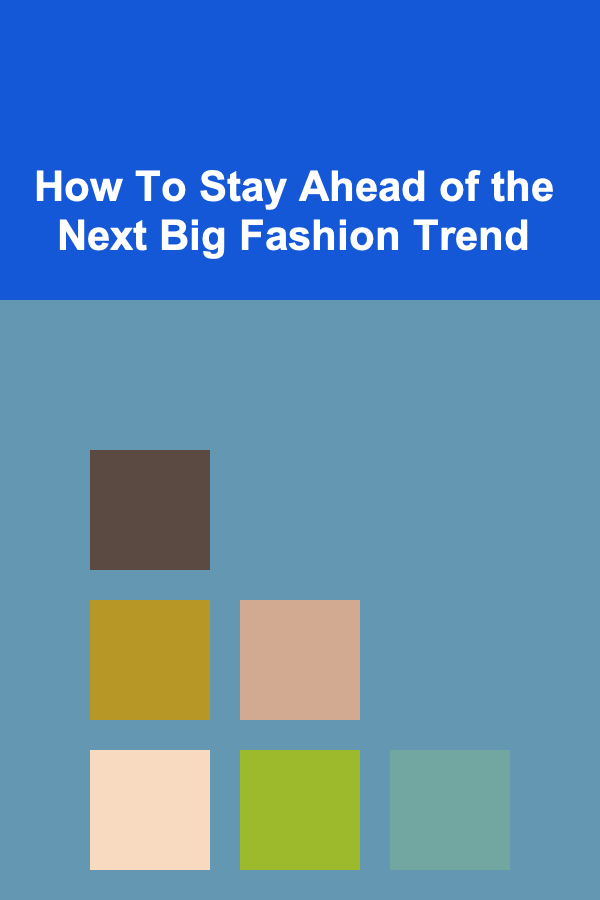
How To Stay Ahead of the Next Big Fashion Trend
ebook include PDF & Audio bundle (Micro Guide)
$12.99$9.99
Limited Time Offer! Order within the next:

Fashion is a constantly shifting industry, where trends rise and fall with the seasons. Whether you're a professional in the fashion industry, a fashion enthusiast, or simply someone who loves to keep up with the latest styles, staying ahead of the next big fashion trend is a valuable skill. Understanding how to anticipate the upcoming trends, interpreting emerging cultural signals, and being strategic in curating your wardrobe or design collections are key aspects of fashion foresight.
This article will explore the steps, insights, and strategies necessary for staying ahead of the next big fashion trend. We'll delve into the sources of influence, methods of tracking trend forecasts, and practical advice on how to incorporate these insights into your personal style or business practices.
Understanding Fashion Cycles
Before we can stay ahead of fashion trends, it's crucial to understand how fashion cycles work. Fashion follows a cyclical pattern, influenced by a variety of factors, including culture, history, and social movements. Trends often evolve slowly, and their rise is shaped by the collective consciousness of consumers, influencers, designers, and the media.
Fashion cycles typically consist of four stages:
- Inception: A trend is first introduced by designers or cultural influencers.
- Adoption: The trend starts gaining traction and is adopted by early adopters, such as celebrities or influential figures.
- Popularization: The trend hits the mainstream and becomes widely adopted by the general public.
- Obsolescence: The trend eventually fades away and is replaced by new ideas or shifts in cultural tastes.
Fashion cycles are not always linear. Some trends come back in a retro or revived form, especially in a world that increasingly looks to past decades for inspiration.
Analyzing Cultural Movements and Social Changes
Fashion is intrinsically linked to cultural, social, and political movements. Major shifts in society, such as changes in technology, global conflicts, environmental concerns, or evolving social norms, often trigger the emergence of new trends.
Technology and Social Media
The rise of social media platforms like Instagram, TikTok, and Pinterest has radically changed the way trends spread. Social media accelerates the trend adoption process, allowing styles to gain popularity globally in a matter of days or even hours. Trends that once took months or years to develop now seem to explode overnight due to the rapid dissemination of visual content.
Fashion influencers play a key role in this process. They help create and popularize styles that would otherwise remain niche. By carefully curating their content and choosing what they wear, they provide their followers with a constant stream of inspiration, making them an essential part of trend forecasting.
Environmental and Ethical Concerns
In recent years, sustainability and ethical fashion have become central to discussions about the future of fashion. As concerns about climate change, pollution, and exploitation of workers rise, consumers are becoming increasingly conscious of the brands they support. This has given rise to trends focused on eco-friendly materials, sustainable manufacturing processes, and a more ethical approach to fashion design.
Brands that embrace sustainable practices and incorporate them into their marketing often find themselves at the forefront of the next big trend. As consumers become more selective, the focus on sustainability continues to shape fashion trends in significant ways.
Social Movements and Political Events
Fashion has always been a reflection of social and political change. For example, the rise of gender-neutral fashion and the popularity of body-positive movements are reflective of ongoing conversations about inclusivity and diversity. These trends are not just fleeting movements but represent larger shifts in societal norms that influence what people wear.
When tracking trends, it's important to remain aware of political climates, cultural shifts, and societal discussions. Fashion often serves as a mirror to these changes, and being tuned into the global conversation can help identify future trends before they take hold.
Following Fashion Forecasts and Industry Professionals
Fashion forecasting is a science in its own right, with professionals working long hours to predict what styles, colors, fabrics, and silhouettes will dominate in the coming seasons. Some of the leading agencies in this space include WGSN, Trendstop, and Fashion Snoops. These agencies analyze data from various industries and apply extensive research to anticipate what consumers will want next.
Color and Fabric Forecasting
One of the most essential aspects of fashion forecasting is understanding which colors and fabrics will be popular. Pantone, a global color authority, releases annual color forecasts that often influence designers' collections for upcoming seasons. These predictions are based on cultural, economic, and social factors that are likely to resonate with consumers.
Similarly, fabric trends also shift with seasons, with innovations in textile production and new fabric developments driving the trend cycle. Sustainable fabrics, recycled materials, and high-tech fabrics designed for functionality have been gaining popularity in recent years.
Major Fashion Weeks and Designer Collections
Fashion weeks held in major cities like New York, Paris, London, and Milan are also key indicators of upcoming trends. These events give designers a platform to showcase their visions for the next season, and often, the collections presented here serve as the blueprint for what will dominate the fashion landscape.
While many consumers may not have access to attend these events, keeping a close eye on the runway shows and analyzing the collections can provide early clues about what will become mainstream.
Collaborating with Innovators and Trendsetters
Innovation often comes from the edges of fashion, where emerging designers, small brands, and creative individuals experiment with new materials, techniques, and designs. These innovators are often the first to introduce bold ideas that later make their way into the mainstream.
Discover Emerging Designers
While established fashion houses like Chanel, Gucci, and Louis Vuitton often dominate the spotlight, some of the most interesting trends come from lesser-known, emerging designers. These creatives are willing to take risks and challenge the status quo, producing groundbreaking work that pushes fashion into new realms.
By keeping an eye on fashion incubators, award shows, and independent fashion shows, you can uncover trends before they hit the mass market.
Collaborations Between Different Industries
Collaborations between fashion designers and other industries---such as music, film, and sports---have become increasingly common. These partnerships often create limited-edition collections or capsule collections that capture the zeitgeist and push boundaries. For example, high-fashion brands frequently team up with streetwear labels or pop culture icons to create products that resonate with younger, trend-conscious consumers.
Global Inspiration and Cultural Exchange
Fashion is a global phenomenon, and staying ahead of trends requires understanding how different cultures around the world influence fashion. Designers often draw inspiration from art, music, and traditional dress from diverse cultures, and trends frequently emerge from these global exchanges.
By embracing global influences and remaining open to new ideas, you can anticipate future trends that are rooted in multicultural influences. This can help create a more inclusive, well-rounded approach to fashion, ensuring that you stay relevant as the global landscape continues to evolve.
Predicting the Future: How to Spot Trends Early
Now that we understand the forces behind fashion trends, how do we spot the next big trend early?
Monitoring Consumer Behavior
One of the most reliable ways to predict fashion trends is to monitor shifts in consumer behavior. Tools like Google Trends, Instagram analytics, and Twitter hashtags can help identify what people are talking about and what they're interested in. Additionally, analyzing purchasing behavior and tracking which products are selling out can provide insights into the direction of the market.
Listening to Trend Experts
Along with industry professionals, there are countless individuals and groups who specialize in identifying and predicting trends. Fashion bloggers, influencers, and even economists often provide invaluable insights into where fashion is heading. By paying attention to these voices, you can gain a deeper understanding of the broader trends that are likely to make an impact.
Pay Attention to Subcultures
Subcultures often provide a breeding ground for the next big fashion trend. Whether it's the skate culture, the DIY movement, or a group of influencers advocating for sustainability, subcultures have long been the incubators for major shifts in fashion. Pay attention to the styles and ideologies emerging from these communities to stay ahead of the curve.
Adapting Trends to Your Personal Style or Business
Once you've identified a trend that's on the rise, the next step is figuring out how to incorporate it into your personal style or business.
Personal Style
Staying ahead of fashion trends doesn't mean you have to follow every trend that comes your way. It's important to adapt trends to your personal taste, body type, and lifestyle. The key to successfully incorporating trends into your wardrobe is to find pieces that feel authentic to your identity while staying fresh and modern.
Business Strategy
For those in the fashion industry, staying ahead of trends can be a competitive advantage. Whether you're a designer, retailer, or marketer, the ability to anticipate trends and offer products that align with emerging styles is critical to success. This involves not just following trends, but understanding consumer behavior, sourcing materials early, and aligning your business strategy with the anticipated direction of the market.
Conclusion
Staying ahead of the next big fashion trend is both an art and a science. By understanding the forces that drive trends, staying tuned into cultural and societal movements, following fashion forecasts, and keeping an eye on emerging talent and subcultures, you can position yourself at the forefront of fashion innovation. Whether you're a consumer looking to curate your wardrobe or a business professional aiming to stay competitive, the key is to stay informed, flexible, and open to new ideas. The world of fashion may be fast-paced and ever-changing, but those who master the art of anticipation will always be one step ahead.

How To Back Up Your Data Securely on the Go
Read More
How to Explore Quantum Computing Platforms and Simulators
Read More
How to Light Your Home for the Perfect Evening Ambiance
Read More
How to Manage Multiple Projects with Digital Tools
Read More
How to Maximize Savings: Taking Advantage of Educational Discounts
Read More
How to Reduce Food Waste and Save Money
Read MoreOther Products

How To Back Up Your Data Securely on the Go
Read More
How to Explore Quantum Computing Platforms and Simulators
Read More
How to Light Your Home for the Perfect Evening Ambiance
Read More
How to Manage Multiple Projects with Digital Tools
Read More
How to Maximize Savings: Taking Advantage of Educational Discounts
Read More